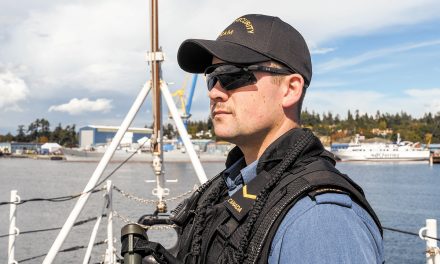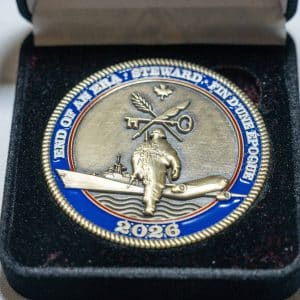
Collin Angus (right), Open Ocean Robotics, prepares to install a hydro phone on the Uncrewed Surface Vehicle Data Xplorer with Connor Grooms of JASCO Applied Sciences. Photo by Corporal (Cpl) Jay Naples, MARPAC Imaging Services, Esquimalt
Peter Mallett
Staff Writer
––
The welfare of marine mammals is at the fore of Defence Research and Development Canada (DRDC)’s recent equipment testing.
A team of researchers launched the surf-board shaped Data Xplorer, a solar powered ocean drone, onto the ocean from Oak Bay’s Cattle Point on Nov. 23.
The technology, developed by Victoria-based Open Ocean Robotics, is a safe, green, and economical way to harvest ocean data.
The goal is to detect marine mammals by towing a passive hydrophone array and recording or sending back data to a command centre. If whales are detected, the navy can use the information to pause, delay, or relocate operations to avoid them.
“The best strategy to reduce the risk of harm to marine mammals is avoidance, and also the development of new automated technology to improve the monitoring of sea life,” says Major Dugald Thomson, a Royal Canadian Air Force officer currently on secondment to DRDC as their Air Liaison Officer.
The ocean drone spent the day sailing near Chatham Island, Discovery Island, and Trial Island recording underwater sounds. The automated processing on board the vehicle detected Baleen whale moans and Pacific white-sided dolphin whistles; these detections will be manually verified after the trial.
Maj Thomson says the Data Xplorer has the potential to deploy at sea prior to military exercises. The Royal Canadian Navy would not own and operate the drone; instead, it would contract out a pre-exercise sweep of a specified area to Open Ocean Robotics.
The potential data the drone can collect is enormous, says Ari Robinson, team lead for Open Ocean Robotics. Aside from passive sonar array data, the Data Xplorer has a 360-degree camera; a weather station that collects oceanographic atmospheric information such as wind speed, temperature, barometric pressure; a wave sensor; multi-beam depth sounder to gather ocean depth and topography information; and additional sensors that can be outfitted.
“It’s satisfying to see something we have worked on for so long out there on the water and testing,” says Robinson. “To get the Data Xplorer working with companies and branches of government, getting feedback, and really delivering is a pretty cool thing.”
So far, they have built three prototypes that can transmit the information to their shore command centre via satellite uplink or a cell phone connection.
Open Ocean Robotics is working closely with JASCO Applied Sciences to develop the autonomous patrol capability. DRDC, meanwhile, is tackling the data problem with a decision support app under development. The app would process and integrate data captured by a multitude of sources including uncrewed platforms like the Data Xplorer, and provide decision support for a ship command team to manage the risks of at-sea operations. They plan to protoype the app in-house over the next two years, says Maj Thomson.
“Once we are done evaluating and developing all of this, we will have a project that we can hand off to the air force and navy so they can implement and put it out to contract.”
Before that can happen, further testing on the Data Xplorer needs to be completed. Phase two testing is planned for late February or early March 2022 at the Canadian Forces Maritime Experimental Test Ranges at Nanoose Bay.
Protection of marine mammals is part of the federal government’s Ocean Protection Plan (2016). It specifically focuses on three endangered cetacean species – Southern Resident Killer Whales, St. Lawrence Belugas, and North Atlantic Right Wales, which may be impacted by anthropogenic noise such as seismic surveys or active sonar use.
The military is actively working to mitigate their impact on ocean-going wildlife. The solution lays in automating marine monitoring, says Maj Thomson, and have that information fed to a central place for instant access by the crew of a ship or aircraft.
“This research is applying advances in passive sonar technology to alert decision makers when whales are nearby,” says Maj Thomson.
He hopes the new technology is a game-changer for military operations.
––––








